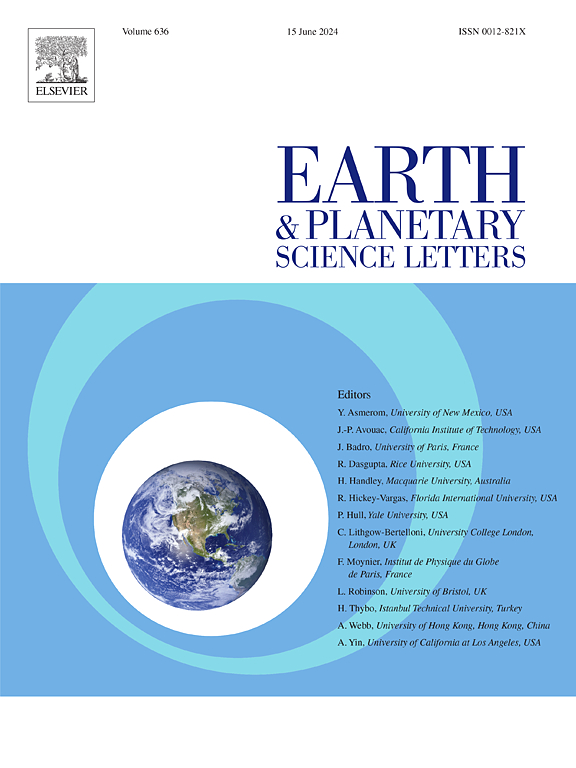地球湿度及其对全球海平面的启示
IF 4.8
1区 地球科学
Q1 GEOCHEMISTRY & GEOPHYSICS
引用次数: 0
摘要
在地质时间尺度上,固体地球形变与依赖气候的地表过程相结合,形成了地球上独特的地表湿度(地表面积随海拔高度的分布),最高的地表面积集中在今天的海面附近。然而,除了在今天的海面上有一个单一的、明确的最大值外,地球的海平面测量还具有一个突出的最大值,位于海平面以上 2-5 米处,其范围考虑了最近的数字高程模型的不确定性。在这里,我们探讨了这个神秘的最大值的性质,并利用一个重力自洽的冰期海平面变化模型,研究了它在上一个冰川周期是如何演变的,以及在接近无冰的未来可能会如何演变。我们认为,海平面最大值捕捉到了上一个冰川期末的地形条件,随后的冰川等静力调整(GIA)将其从海面抬升到了今天的高度。此外,在未来没有冰雪量减少的情况下,正在进行的冰川等静力调整将使最高点再升高 2 米。如果部分测湿最高点的持续时间长于全新世的时间尺度,那么由此产生的全球增量影响叠加后的测湿最高点在海面以上+4-7米处的升高,就意味着地球较长期的平均状态,可能反映了较低的冰量、侵蚀趋势、动态地形或这些因素的组合。这些不同因素对现今湿度测量的影响与海岸线附近侵蚀和沉积过程的时间尺度密切相关。本文章由计算机程序翻译,如有差异,请以英文原文为准。
Earth's hypsometry and what it tells us about global sea level
Over geological time scales, the combination of solid-Earth deformation and climate-dependent surface processes have resulted in a distinct hypsometry (distribution of surface area with elevation) on Earth, with the highest concentration of surface area focused near the present-day sea surface. However, in addition to a single, well-defined maximum at the present-day sea surface, Earth's hypsometry is also characterized by a prominent maximum ∼2–5 m above this level, with the range accounting for uncertainties in recent digital elevation models. Here we explore the nature of this enigmatic maximum and examine, using a gravitationally self-consistent model of ice-age sea-level change, how it evolved over the last glacial cycle and may evolve moving towards a near-ice-free future. We argue that the hypsometric maximum captures topographic conditions at the end of the last deglaciation phase and subsequent glacial isostatic adjustment (GIA) raised it from the sea surface to its present-day elevation. Moreover, ongoing GIA will raise the maximum a further ∼2 m in the absence of future ice mass loss. If a portion of the hypsometric maximum has persisted for longer than Holocene time scales, the resulting GIA-converged elevation of the hypsometric maximum at +4–7 m above the sea surface implies a longer-term mean state of the Earth that may reflect lower ice volumes, trends in erosion, dynamic topography, or a combination of these. The signature of these various contributions on present-day hypsometry is intimately connected to the time scale of erosional and depositional processes near shorelines.
求助全文
通过发布文献求助,成功后即可免费获取论文全文。
去求助
来源期刊

Earth and Planetary Science Letters
地学-地球化学与地球物理
CiteScore
10.30
自引率
5.70%
发文量
475
审稿时长
2.8 months
期刊介绍:
Earth and Planetary Science Letters (EPSL) is a leading journal for researchers across the entire Earth and planetary sciences community. It publishes concise, exciting, high-impact articles ("Letters") of broad interest. Its focus is on physical and chemical processes, the evolution and general properties of the Earth and planets - from their deep interiors to their atmospheres. EPSL also includes a Frontiers section, featuring invited high-profile synthesis articles by leading experts on timely topics to bring cutting-edge research to the wider community.
 求助内容:
求助内容: 应助结果提醒方式:
应助结果提醒方式:


